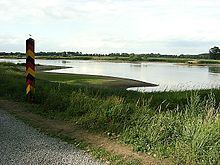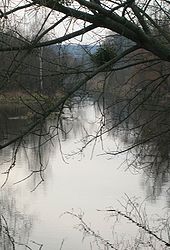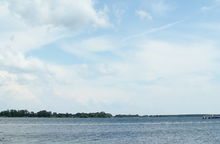- Oder
-
Oder (Odra) River Oder between Kienitz and Zollbrücke, GermanyCountries Czech Republic, Poland, Germany Source - location Oderské vrchy, Silesia, Czech Republic Mouth Szczecin Lagoon - location Baltic Sea, Poland - coordinates 53°40′19″N 14°31′25″E / 53.67194°N 14.52361°E Length 854 km (531 mi) Basin 118,861 km2 (45,892 sq mi) Discharge mouth - average 574 m3/s (20,271 cu ft/s) The Oder (German: Oder [ˈoːdɐ]; Czech/Polish: Odra) is a river in Central Europe. It rises in the Czech Republic and flows through western Poland, later forming 187 kilometres (116 mi) of the border between Poland and Germany, part of the Oder-Neisse line. The river ultimately flows into the Szczecin Lagoon north of Szczecin and then into three branches (the Dziwna, Świna and Peene) that empty into the Gulf of Pomerania of the Baltic Sea.
Contents
Names
The Oder is known by several names in different languages, but the modern ones are very similar: (English and German: Oder; Czech, Polish, and Lower Sorbian: Odra, Upper Sorbian: Wódra; Kashubian: Òdra (pronounced [ˈwɛdra]); Medieval Latin: Od(d)era); Renaissance Latin: Viadrus (invented in 1534). Claudius Ptolemaios gives for the localization of modern Oder a river Συήβος (Suebos, Latin: Suevus, from the name for the tribe of the Suebi), which resembles the modern name Świna for the main connection from the Oder Lagoon to the Baltic Sea. A mouth named Οὐιαδούα (or Οὐιλδούα, graphical similarity of Α and Λ), therefore Latin Viadua or Vildua, is localized by him at one third of the distance between Suebos and Vistula, maybe it is modern Wieprz.[1][2] In Old Church Slavonic language, the name of the river was Vjodr.[3]
Geography
The Oder is 854 km long: 112 in the Czech Republic, 742 in Poland (including 187 on the border between Germany and Poland) and is the second longest river in Poland (after the Vistula). It drains a bassin of 118,861 km², 106,056 of which are in Poland (89%), 7,217 in the Czech Republic (6%), and 5,587 in Germany (5%). Channels connect it to the Havel, Spree, Vistula system and Kłodnica. It flows through Silesian, Opole, Lower Silesian, Lubusz, and West Pomeranian voivodeships of Poland and the states of Brandenburg and Mecklenburg-Vorpommern in Germany.
The main branch empties into the Szczecin Lagoon near Police. The Szczecin Lagoon is bordered on the north by the islands of Usedom (west) and Wolin (east). Between these two islands, there is only a narrow channel (Świna) going to the Bay of Pomerania, which forms a part of the Baltic Sea.
The largest city on the Oder River is Wrocław, in Lower Silesia.
The Oder is navigable over a large part of its total length, as far upstream as to the town of Koźle, where the river connects to the Gliwicki Canal. The upstream part of the river is canalized and permits larger barges (up to CEMT Class IV) to navigate between the industrial sites around the Wrocław area.
Further downstream the river is free flowing, passing the towns of Eisenhüttenstadt (where the Oder–Spree Canal connects the river to the Spree in Berlin) and Frankfurt upon Oder. Downstream of Frankfurt the Warta River forms a navigable connection with Poznań and Bydgoszcz for smaller vessels. At Hohensaaten the Havel-Oder-Wasserstrasse connects with the Berlin waterways again.
Near its mouth the Oder reaches the city of Szczecin, a major maritime port. The river finally reaches the Baltic Sea through the Szczecin Lagoon and the river mouth at Świnoujście. (Source: NoorderSoft Waterways Database)
History
The river in Germania Magna was known to the Romans as the Viadrus or Viadua in Classical Latin, as it was a branch of the Amber Road from the Baltic Sea to the Roman Empire (see via). In German it was and is called the Oder, written in older records as Odera or Oddera in Medieval Latin documents and was mentioned in the Dagome iudex, which described territory of Duke Mieszko I ca. 990 and Oda von Haldensleben.
The Oder was an important trade route and towns in Germania were documented along with many tribes living between the rivers Albis (Elbe), Viadrus and Vistula. Centuries later the Bavarian Geographer (ca. 845) specifies the following Westslavic peoples: Sleenzane, Dadosesani, Opoloni, Lupiglaa, and Gоlеnsizi in Silesia and Wolinians and Pyrzycans in Western Pomerania. A document of the Bishopric of Prague (1086) mentions Zlasane, Trebovyane, Poborane, and Dedositze in Silesia. In the 13th century, the first dams were built to protect agricultural lands.
The Finow Canal, built for the first time in 1605, connects Oder and Havel. After completion of the more straight Oder Havel Canal in 1914, its economic relevance decreased.
The earliest important undertaking with a view of improving the waterway was due to the initiative of Frederick the Great, who recommended the diversion of the river into a new and straight channel in the swampy tract of land known as Oderbruch near Küstrin. The work was carried out in the years 1746-1753, a large tract of marshland being brought under cultivation, a considerable detour cut off and the main stream successfully confined to a canal.
In the late 19th century three additional alterations were made to the waterway.
- The canalization of the main stream at Breslau, and from the confluence of the Glatzer Neisse to the mouth of the Klodnitz Canal, a distance of over 50 miles (80 km). These engineering works were completed in 1896.
- During 1887-1891 the Oder–Spree Canal was made to connect the two rivers named.
- The deepening and regulation of the mouth and lower course of the stream.
By the Treaty of Versailles the navigation on the Oder became subject to International Commission of the Oder.[4] Following the articles 363 and 364 of the Treaty Czechoslovakia was entitled to lease in Stettin (now Szczecin) its own section in the harbour, then called Tschechoslowakische Zone im Hafen Stettin.[5] The contract of lease between Czechoslovakia and Germany, and supervised by the United Kingdom, was signed on February 16, 1929 and would end in 2028, however, after 1945 Czechoslovakia did not regain this legal position, de facto abolished in 1938/1939.
At the 1943 Tehran Conference the allies determined the new Eastern border of Germany to run along the Oder[6] but after World War II, the Oder and the Lusatian Neisse formed the Oder-Neisse line, which was designated by Poland as the new border between itself and Germany. The German populations east of these two rivers were forcibly expelled westwards. East Germany confirmed the border with Poland in 1950, then West Germany, after a period of refusal, finally accepted the border in 1970. In 1990 newly reunified Germany and the Republic of Poland signed a treaty recognizing it as their border.
Cities
Main section:
- Ostrava - Bohumín - Racibórz - Kędzierzyn-Koźle - Krapkowice - Opole - Brzeg - Oława - Jelcz-Laskowice - Wrocław - Brzeg Dolny - Ścinawa - Szlichtyngowa - Głogów - Bytom Odrzański - Nowa Sól - Krosno Odrzańskie - Eisenhüttenstadt - Frankfurt (Oder) - Słubice - Kostrzyn - Cedynia - Schwedt - Vierraden - Gartz - Gryfino - Szczecin - Police
Dziwna branch (between Wolin Island and mainland Poland):
Świna branch (between Wolin and the Usedom islands):
Szczecin Lagoon:
Peene branch (between Usedom Island and the German mainland):
Eastern tributaries
- Ostravice - Olza - Ruda - Bierawka - Kłodnica - Czarnka - Mała Panew - Stobrawa - Widawa - Jezierzyca - Barycz - Krzycki Rów - Obrzyca - Jabłonna - Pliszka - Ołobok - Gryzynka - Warta with the Noteć - Myśla - Kurzyca - Stubia - Rurzyca - Tywa - Płonia - Ina - Gowienica
Western tributaries
- Opava - Psina (Cyna) - Cisek - Olszówka - Stradunia - Osobłoga - Prószkowski Potok - Nysa Kłodzka - Oława - Ślęza - Bystrzyca - Średzka Woda - Cicha Woda - Kaczawa - Ślepca - Zimnica - Dębniak - Biała Woda - Czarna Struga - Śląska Ochla - Zimny Potok - Bóbr - Olcha - Racza - Lusatian Neisse - Finow - Gunica
Notes
- ^ Claudius Ptolemaios: Geographike Hyphegesis, Kap. 11: Germania Magna. (altgriech./lat./engl.)
- ^ Ralf Loock: Mündungen der Flüsse bestimmt. In: Märkische Oderzeitung, Frankfurt 2008,3 (März); Ralf Loock: Namenskrimi um Viadrus in: Märkische Oderzeitung – Journal. Frankfurt 25./26. Nov. 2006, S. 2; siehe auch Alfred Stückelberger, Gerd Graßhoff (Hrsg.): Ptolemaios – Handbuch der Geographie. Schwabe, Basel 2006, S. 223, ISBN 3-7965-2148-7
- ^ Encyclopædia Britannica's 9th edition 1870–1890: Oder&
- ^ The commission was staffed with one representative of Czechoslovakia, Denmark, France, Poland, Sweden, and the United Kingdom each and three representatives of Prussia, being the German state competent for the navigable section of the Oder, comprised within the latter's borders. Cf. Der Große Brockhaus: Handbuch des Wissens in zwanzig Bänden: 21 Bde., completely revised ed., Leipzig: F. A. Brockhaus, 151928-1935, vol 13 (1932): Dreizehnter Band Mue–Ost, article: 'Oder', pp. 600seq., here p. 601. No ISBN.
- ^ Cf. Archiwum Państwowe w Szczecinie (State Archive of Szczecin), Rep. 126, Krajowy Urząd Skarbowy w Szczecinie [1]
- ^ Allen DJ (2003)The Oder-Neisse line: the United States, Poland, and Germany in the Cold War, Praeger P13
See also
- List of rivers of Germany
- List of rivers of Poland
- Lower Odra Valley National Park
- Maritsa river, which marks the modern land border between Greece and Turkey
- Oder-Neisse line
External links
- multi-lingual information site on the Oder river
- Odra River electronic shipping guide
- Bibliography on Water Resources and International Law Peace Palace Library
Odra Vistula Lagoon Baltic Sea Silesia topics History Symbols Coats of arms · Flags · Unofficial Anthems: Schlesien Unvergessene Heimat · Schlesierlied · Slezská hymnaEconomy Tourism · Upper Silesian Coal Basin (with: Upper Silesian Industrial Region · Rybnik Coal Area · Ostrava-Karviná Coal Area) · Lower Silesian Coal Basin · Legnicko-Głogowski Okręg Miedziowy · Bielski Okręg Przemysłowy · Silesian metropolitan area · Katowice urban areaCuisine Silesian dumplings · Black noodles · Makówki · Siemieniotka · Żur śląski · Wodzionka · Szałot · Kreple · Kołocz · Galert · Krupniok · Karminadle · Bryja · Moczka · Modra kapusta · Ciapkapusta · HauskyjzaLanguages Silesian (Cieszyn Silesian dialect · Lach Silesian dialect · Niemodlin Silesian dialect · Bytom Silesian dialect · Jabłonków Silesian dialect · Namysłów Silesian dialect · Prudnik Silesian dialect · Opole Silesian dialect · Syców Silesian dialect · Lower Silesian dialect · Sulkovian Silesian dialect · Texas Silesian) · German · Polish · Czech · Lower SilesianAdministrative
divisionsFormerDuchies (Piasts · Dukes) · Silesian Voivodeship (1920–1939) (Parliament · Treasury · Politicians) · State country · Province of Silesia / Upper Silesia / Lower Silesia · Sudetenland · New Silesia · Austrian Silesia · Eastern SilesiaPresentSilesian · Opole · Lower Silesian · Lubusz Voivodeships · Silesian-Moravian Region · Jeseník District · part of Saxony and Brandenburg (mainly in Niederschlesischer Oberlausitzkreis/Görlitz (district))Geography MountainsRiversOderLakesHighlands
Lowlands
OtherSilesian Highlands · Silesian Lowlands · Silesian-Lusatian Lowlands · Silesian Foothills · Silesian-Moravian Foothills · Oświęcim Valley · Ostrava Valley · Jelenia Góra valley · Kłodzko Valley · Zielona Góra Acclivity · Wał Trzebnicki · Przedgórze Sudeckie · Obniżenie Milicko-Głogowskie · Silesia Walls · Lower Silesian Wilderness · Silesian PrzesiekaOther Silesians · Silesian regional costumes (Śląskie stroje ludowe) · Silesian Autonomy Movement · Landsmannschaft Schlesien · Silesian architecture · Silesia national football team · Silesian Stadium · Silesian Football Association · Silesian-Moravian Football League · Silesian (European Parliament constituency) · Lower Silesian and Opole (European Parliament constituency) · Evangelical Church of Berlin-Brandenburg-Silesian Upper Lusatia · Silesian Evangelical Church of Augsburg Confession · FamilokGeography of Pomerania Regions CurrentVorpommern (Western or Hither Pomerania) · Zachodniopomorskie · Pomerelia (Kashubia) · Pomerania euroregionAdministration Towns ListsList of towns in Vorpommern · List of towns in Farther Pomerania · Pomeranian cities, towns and villages · List of placenames in the Province of Pomerania (A-H · I-P · Q-Z)Largest>100,000>50,000Islands Peninsulae Rivers Lakes Bays, lagoons National parks  This article incorporates text from a publication now in the public domain: Chisholm, Hugh, ed (1911). Encyclopædia Britannica (11th ed.). Cambridge University Press.Categories:
This article incorporates text from a publication now in the public domain: Chisholm, Hugh, ed (1911). Encyclopædia Britannica (11th ed.). Cambridge University Press.Categories:- Oder basin
- Rivers of the Olomouc Region
- Rivers of the Moravian-Silesian Region
- Rivers of Poland
- Rivers of Brandenburg
- Rivers of Mecklenburg-Vorpommern
- International rivers of Europe
- Germany–Poland border
Wikimedia Foundation. 2010.







